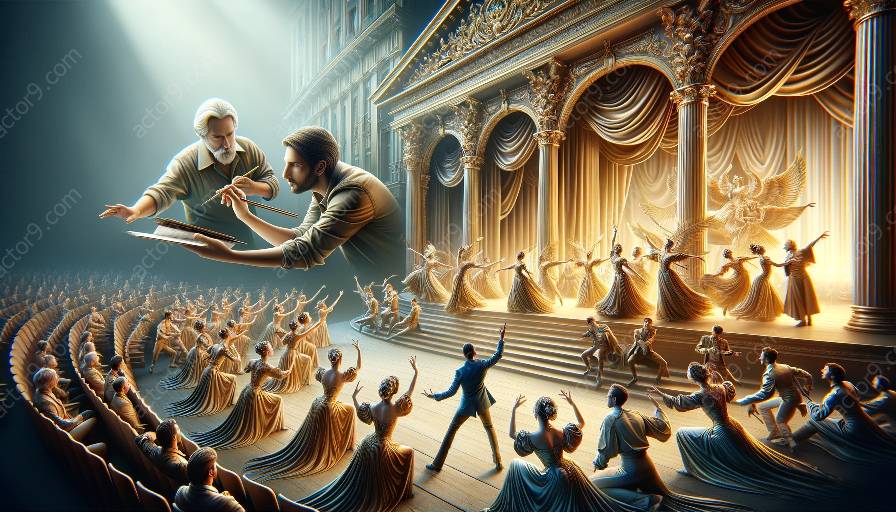Opera directing and choreography are two vital components of the rich tapestry of performing arts, serving as the creative backbone of operatic productions. These disciplines shape the visual, emotional, and narrative elements that unfold on stage, captivating audiences with their seamless integration of music, movement, and storytelling. This comprehensive guide delves into the intricate world of opera directing and choreography, exploring their compatibility with opera performance and their convergence with the broader spectrum of performing arts, including acting and theater.
Unveiling the Art of Opera Directing
Opera directing encompasses the multifaceted art of translating musical compositions and librettos into captivating stage productions. Directors infuse their creative vision into every aspect of the opera, from character portrayals and stage design to the overall thematic interpretation. Central to the role is the ability to interweave the conductor's musical direction with dramatic storytelling, resulting in a harmonious fusion of music and theatrical performance.
Opera directors engage in meticulous planning and collaboration, working closely with set designers, costume artists, and lighting technicians to bring their vision to life. They carefully consider the spatial dynamics and stage movements, orchestrating the interactions among performers to convey the opera's emotional depth and narrative complexity. As the mastermind behind the production, the director's keen insight into character development and dramatic pacing shapes the audience's engagement with the performance, guiding them through a transformative journey of music and storytelling.
Artistry in Opera Choreography
Opera choreography enriches the operatic experience by infusing expressive movement and dance sequences into the storytelling. Choreographers collaborate closely with the director and conductor to craft choreographed movements that amplify the emotional resonance of the music and libretto. Whether through graceful pas de deux in romantic operas or dynamic ensemble numbers in grand spectacles, opera choreography enhances the visual and visceral impact of the performance.
The choreographer's expertise lies in seamlessly blending dance with dramatic narrative, enhancing the operatic storytelling through captivating movement compositions. Their creative process involves interpreting the music's rhythm and emotional nuances, crafting choreography that resonates with the opera's thematic elements and character dynamics. With a keen focus on precision and expression, opera choreographers contribute to the cohesion of the production, ensuring that each movement embodies the spirit of the music and libretto.
Weaving Artistic Vision on Stage
When opera directing and choreography intertwine, a mesmerizing synergy emerges, captivating audiences with a seamless fusion of music, movement, and theatrical storytelling. The collaborative efforts of directors, choreographers, conductors, and performers converge to shape a visually stunning and emotionally compelling operatic experience. This union of artistic disciplines extends beyond the realm of opera, resonating with the broader landscape of performing arts, including acting and theater.
Compatibility with Opera Performance
Opera directing and choreography form the cornerstone of operatic performance, imbuing productions with visual splendor, dramatic depth, and narrative coherence. Directors and choreographers collaborate with opera singers, instrumentalists, and stage performers to create a cohesive and immersive artistic tapestry. Through meticulous attention to detail and artistic synergy, these creative visionaries elevate opera performances to resonate with audiences on both an emotional and aesthetic level.
Intersection with Performing Arts: Acting and Theater
Within the realm of performing arts, opera directing and choreography interface with acting and theater, fostering a dynamic exchange of artistic techniques and storytelling approaches. The fusion of music, movement, and theatrical expression expands the boundaries of traditional performance, offering a riveting synthesis of artistic disciplines. Opera directors and choreographers draw inspiration from dramatic traditions while infusing operatic storytelling with innovative theatrical elements, creating a captivating fusion of classical and contemporary artistic sensibilities.
Shaping Artistic Innovation
The confluence of opera directing, choreography, opera performance, and the broader spectrum of performing arts engenders a platform for artistic innovation. It serves as a fertile ground for exploring new narrative dynamics, visual aesthetics, and emotive storytelling, pushing the boundaries of traditional operatic conventions while honoring the rich heritage of the art form. As these creative disciplines continue to evolve, their resonance within the performing arts landscape reflects a timeless and ever-evolving tapestry of human expression and artistic endeavor.
Conclusion
Opera directing and choreography stand as pillars of artistic ingenuity, elevating operatic performances to immersive and unforgettable experiences. Their compatibility with opera performance and their interplay with the broader realm of performing arts underscore their profound impact on the collective tapestry of human creativity. By delving into the intricate nuances of these disciplines, we gain a deeper appreciation for the collaborative artistry and storytelling prowess that define the captivating world of opera on stage.































